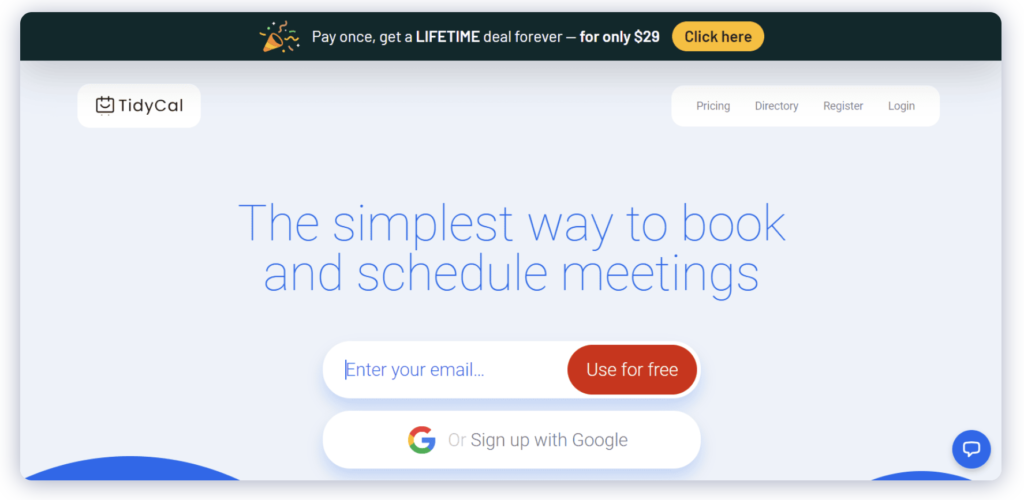
If you’re looking for a simple and affordable way to manage your meetings, this TidyCal review will give you a clear picture of what to expect.
I’ve tested TidyCal to see how well it handles scheduling, integrations, and booking management compared to other tools.
TidyCal stands out because it offers a lifetime deal for $29, making it a cost-effective option for small business owners and entrepreneurs who want easy scheduling without monthly fees.
The tool covers all the basics you need, such as calendar syncing with Google, Apple, and Outlook, video call integrations, and useful features like group bookings and reminders. It has a clean interface that’s easy to navigate, which makes setting up appointments quick even if you’re new to scheduling software.
If you want a straightforward appointment planner that grows with your needs but won’t break the bank, this review will help you decide if TidyCal is right for you.
Key Takeways
- TidyCal offers a budget-friendly lifetime plan with essential scheduling tools.
- It supports major calendar and video conferencing integrations.
- The platform is easy to use and fits well for small business owners and solopreneurs.
TidyCal Overview
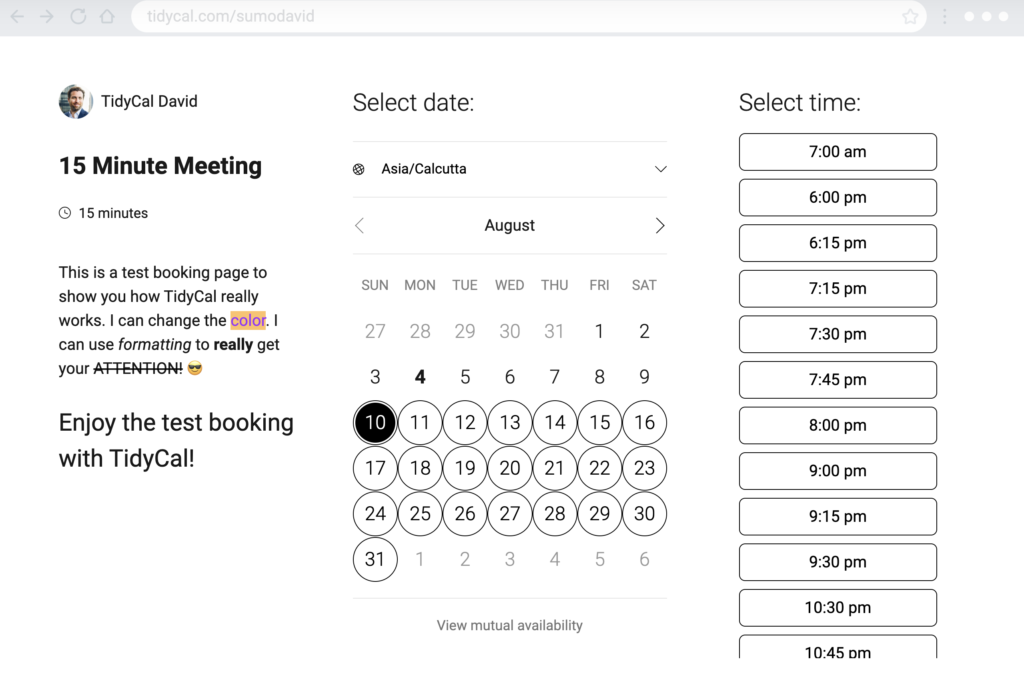
TidyCal is a simple yet practical scheduling software designed to help users manage appointments without unnecessary complexity. It offers key features that balance ease of use with essential functionality. My experience with it shows it focuses on efficiency and straightforward booking.
What Is TidyCal?
TidyCal is an appointment scheduling tool targeted mainly at freelancers, consultants, and small business owners. Its main appeal lies in its minimalist design and straightforward functionality. Unlike more complex platforms, it avoids overwhelming users with extra features they might not need.
One standout feature is its lifetime deal through AppSumo, which means I paid once and got access to premium features without subscription fees. It supports syncing with popular calendars like Google Calendar and Microsoft Outlook, which keeps bookings organized and conflict-free.
How TidyCal Works
Using TidyCal begins with creating a personalized booking page. I set my available times and link my calendars to avoid double bookings. Then, I share the booking link with clients.
Clients can choose a time based on my availability without going back and forth by email. The app automatically syncs confirmed meetings to my calendar.
The paid version also allows accepting payments via PayPal or Stripe, which is beneficial for consulting or paid appointments. This feature streamlines the scheduling and payment process in one place.
TidyCal User Interface
TidyCal has a clean, minimalist interface focused on ease of use. The dashboard shows upcoming bookings, available time slots, and settings clearly.
Navigation is straightforward: I can update availability, customize booking types, and check appointments quickly. The simplicity means less time spent learning the app, allowing me to focus more on productivity.
The booking pages are mobile-friendly and can be embedded on websites or shared via a link. This flexibility improves client access without complicated setup steps.
For those looking for a scheduling tool with few distractions, TidyCal’s user interface hits the mark.
Key Features of TidyCal
TidyCal offers a set of practical tools that help me manage appointments without hassle. Its features cover different meeting types, handling payments, organizing group sessions, and sending reminders to keep everyone on track.
Booking Types
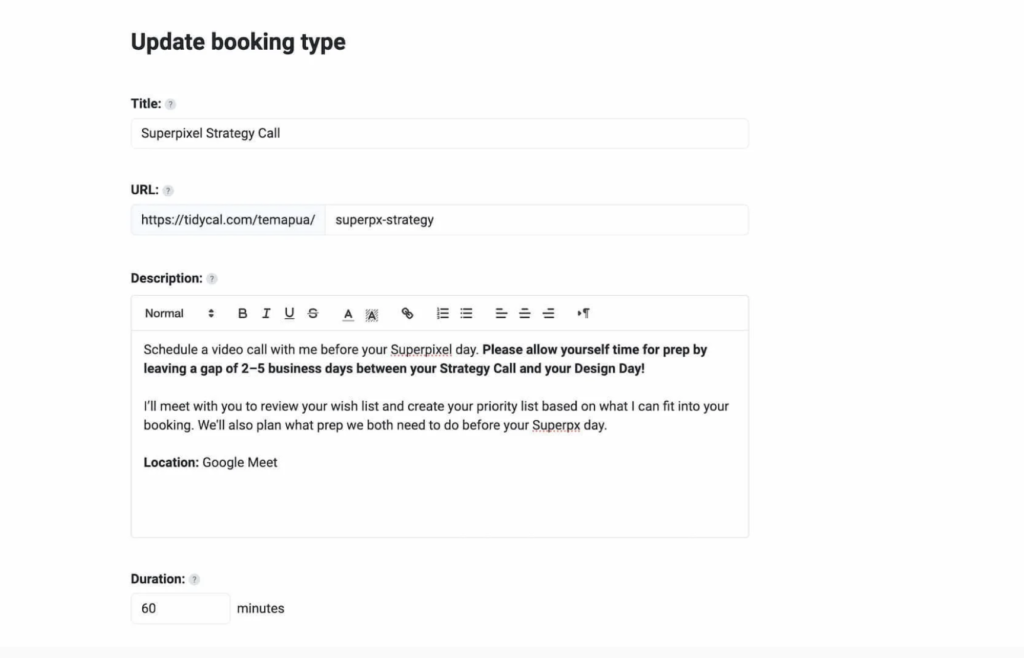
I can create multiple booking types to fit my needs. Whether it’s a quick 15-minute check-in or a longer one-hour consultation, I control the length and availability of each option. This flexibility means I don’t have to squash all meetings into one format.
Booking pages are easy to set up and share. My clients see the specific meeting options I offer and pick times that work for them. I can also mix free and paid bookings, which helps with different services or priorities I have.
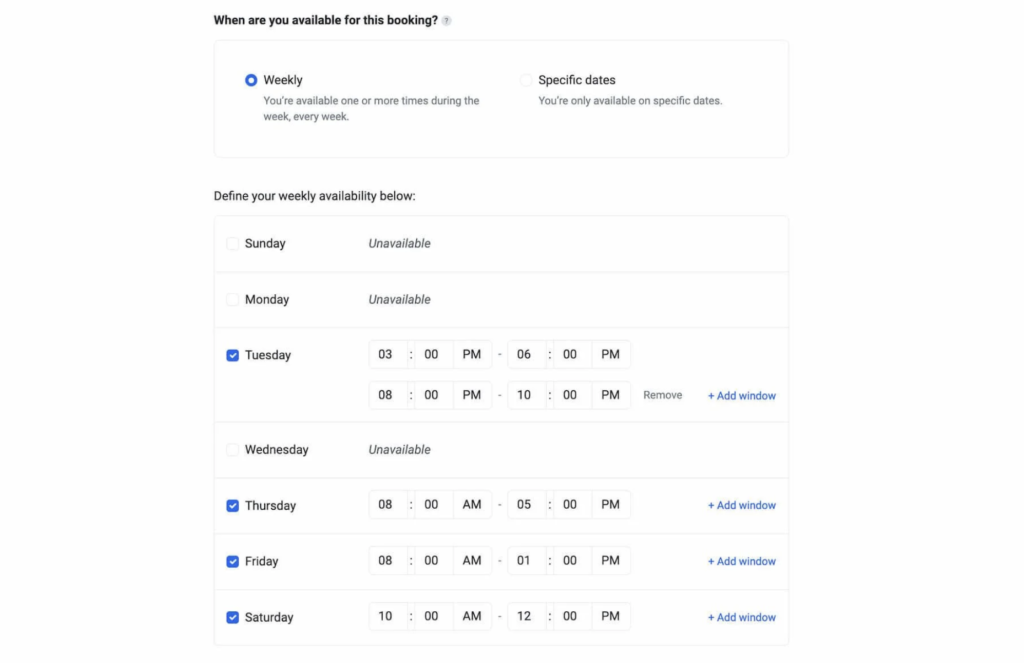
Paid Bookings and Payment Options
For paid bookings, TidyCal integrates smoothly with Stripe and PayPal. This setup lets me accept payments upfront directly on my booking page. My clients can pay as they book, which avoids chasing payments later.
I can set different prices for various booking types. For example, a detailed coaching session can have a higher fee than a casual consultation. The payment process is simple and secure, which builds trust with clients.
Group Bookings
TidyCal supports group bookings, so I can schedule sessions with several clients at once. This feature works well if I run workshops or group coaching calls.
Each group session has a set number of spots. Once it’s full, new bookings are automatically blocked, preventing overbooking. It saves me from manually tracking attendees, which keeps scheduling smooth.
Custom Email Reminders
I can set up custom email reminders that go out automatically before appointments. These reminders reduce no-shows by keeping clients informed and prepared.
The emails are personalized to my brand and message. I choose when and how often to send them, which helps clients remember important details and times. This feature cuts down on last-minute cancellations and helps me keep my schedule organized.
Integrations and Calendar Connections
TidyCal’s ability to connect with multiple calendars and tools makes managing schedules easier. It supports popular calendar apps and tools for video meetings and payments, helping me keep appointments and bookings all in one place. These integrations reduce the chance of double bookings and simplify how I organize meetings.
TidyCal Integrations
TidyCal connects with several important apps to build a smooth scheduling workflow. It integrates with video conferencing tools like Zoom, Google Meet, and Microsoft Teams. This means meeting links get added automatically when someone books a slot.
It also supports payment services such as PayPal and Stripe. That lets me schedule paid appointments simply, without extra hassle.
Zapier integration is available too, which helps automate certain actions by connecting TidyCal to over 4,000 other apps. For Pro users, API access offers even more flexibility to customize workflows.
I find these integrations vital for making scheduling efficient and professional across different platforms. You can learn more about these features through the detailed list of TidyCal integrations.
Google Calendar and Apple Calendar
The main calendar connections I rely on are Google Calendar and Apple iCal. TidyCal syncs in real time with these calendars, so I always see my updated availability.
This real-time syncing prevents double bookings by updating immediately when an appointment is made elsewhere. Android and iOS users benefit from these integrations because they cover the two most widely used calendar platforms.
Google Workspace users and those on Outlook 365 also get smooth syncing options. I can connect up to ten calendars, which is enough for managing both personal and work schedules.
This level of integration keeps my day organized without manual checking or updating, an important feature for anyone juggling many appointments.
Other Scheduling Tools Integration
While TidyCal focuses primarily on direct calendar connections, it plays well with external scheduling apps indirectly through Zapier. This means I can connect TidyCal to tools like Calendly or Acuity and automate workflows between them.
However, TidyCal does not directly sync with other scheduling tools but instead uses its integrations to fit into larger productivity setups. This approach works well if you want a centralized scheduler that communicates with a broader digital workspace.
Its API also lets advanced users build custom solutions if native integrations are not enough. This flexibility is a key benefit compared to other tools that limit you to only built-in connections.
Booking Management
Managing bookings well means controlling when you’re available, guiding clients after they book, and easily sharing your booking links. These factors help reduce scheduling conflicts and make the whole process smoother for both you and your clients.
Setting Availability
I found that setting availability in TidyCal is straightforward and flexible. You can define specific days and time slots when you’re open for meetings. This includes setting recurring hours each week, which saves time from resetting your schedule regularly.
TidyCal also allows buffer times before or after appointments. This ensures you have breaks between meetings and prevents back-to-back bookings from causing stress. Plus, you can limit the number of appointments per day to avoid overloading yourself.
All these settings are easy to customize from the dashboard. It helps me keep control of my calendar without guessing or risking overlaps.
Confirmation Redirects
After a client books an appointment, you can use confirmation redirects to send them to a custom page. This feature lets me provide immediate next steps, like sharing important information, welcoming messages, or links to join a meeting.
Using confirmation redirects also improves client experience. Instead of just showing a basic “Thank you” message, I can guide my clients exactly where I want them to go. This reduces confusion and speeds up communication.
You can set the redirect URL for each booking type, allowing tailored instructions depending on the service booked. This feature adds a professional touch and keeps the booking process clear.
Embedding and Sharing Booking Links
TidyCal makes sharing booking pages simple and flexible. You can embed your booking links directly on your website using HTML code. This lets visitors schedule appointments without leaving your site.
Beyond websites, the booking links can be shared through email, social media, or messaging apps. I often send my unique link through email campaigns to reach clients faster.
The booking pages are customizable to match your style and appointment types. This means your clients see clear options for the services you offer. Whether it’s free consultations or paid sessions, sharing is quick and user-friendly.
TidyCal Lifetime Deal and Pricing
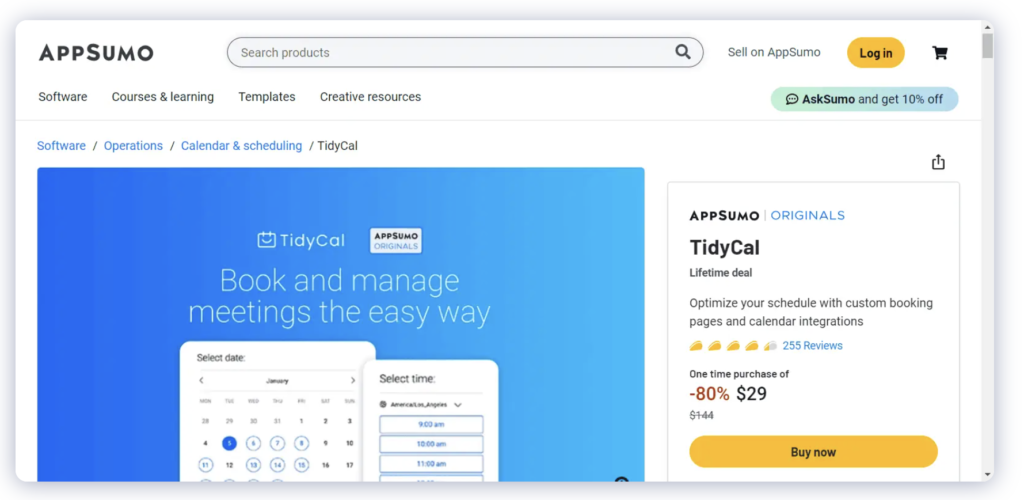
TidyCal offers options that let you pay once or subscribe monthly. The lifetime deal gives you full access without ongoing fees, while subscription plans provide flexibility with smaller monthly payments.
Each approach suits different needs depending on how often you use the tool and your budget.
AppSumo Lifetime Deal
The AppSumo lifetime deal is a one-time payment of $29, often with a 10% discount for first-time buyers. This deal grants unlimited access to all current and future TidyCal features.
You don’t need to worry about monthly or annual charges, which helps save money over time.
This purchase includes free updates and support. The deal is only available on AppSumo and tends to sell out quickly. If you want to avoid recurring fees and use TidyCal long-term, this is the best option to consider.
Comparison With Subscription Plans
TidyCal also offers monthly plans priced around $12 per user. These include the basic features for scheduling but require continuous payments to keep using the service. Compared to the lifetime deal, subscriptions cost more if you plan to use TidyCal for over two years.
The monthly plans may suit users who do not need TidyCal permanently or want to try it first without a big upfront cost. However, you get fewer perks with subscriptions, like limited access to all future updates.
Value for Money
I find the lifetime deal to be the best value if you expect regular use. Paying once for $29 locks in all features for life and avoids the hassle of renewing your plan every month or year.
Subscription pricing can add up over time, especially if you manage multiple calendars or teams. The lifetime deal also supports unlimited booking types and integrations, which can boost productivity without extra costs.
Buying TidyCal through AppSumo’s lifetime deal is a smart choice if you want a reliable scheduling tool that won’t increase your expenses down the road. For pricing details, check the TidyCal lifetime deal on AppSumo.
Pros and Cons
TidyCal offers useful features at an affordable price, making it a solid choice for many users. But it also has some clear limits, especially if you need advanced tools or mobile accessibility. Here’s a closer look at what stands out and what falls short.
Advantages of TidyCal
I appreciate TidyCal’s simple and clean interface. It’s easy to set up booking pages without confusion or a steep learning curve. The one-time payment model is a big plus because I don’t have to worry about monthly fees.
TidyCal supports different meeting types, like one-on-one, group, collective, and round-robin events, which fits many business needs. Recurring meetings and customized email reminders are helpful for managing schedules and reducing no-shows.
I also like the payment options through Stripe and PayPal, so you can charge for appointments directly. The ability to sync multiple calendars prevents double bookings efficiently. It covers all the basics well at a low cost.
Limitations and Drawbacks
On the downside, the free plan is quite limited. You only get one calendar connection and no direct video call integration, which might be a problem if you want to keep everything streamlined in one platform.
I found that TidyCal lacks a mobile app for Android or iOS, which makes on-the-go scheduling harder. The number of native integrations is also low, especially compared to other tools like Calendly or Cal.com.
While the platform offers analytics, they are basic and might not meet the needs of larger teams or those wanting detailed reports. For advanced scheduling and team collaboration, these gaps can be significant.
Who Should Use TidyCal?
TidyCal works best for people who need a simple way to manage meetings and appointments. It fits well for those who want to save time scheduling and avoid confusion with calendar overlaps. The tool helps users customize their booking process and handle payments easily.
Best Use Cases
I find TidyCal especially useful for scheduling one-on-one meetings, group sessions, and paid consultations. You can create different booking types with various durations and purposes. It also supports automatic meeting links for Zoom or Google Meet, which speeds up virtual meeting setup.
Using TidyCal for workshop sign-ups or online classes works well because you can set custom availability and buffer times between bookings. It’s also helpful for handling client appointments where you need to collect payments upfront through Stripe or PayPal.
Industries and Roles Benefiting From TidyCal
Freelancers and consultants benefit from TidyCal by easily managing client meetings and charging for sessions. Small business owners use it to coordinate team meetings and customer bookings without monthly fees.
Educators appreciate how it handles tutoring sessions or group classes. Healthcare providers can schedule patient visits and follow-ups with customization for different appointment types. The tool’s calendar sync with Google, Office 365, and iCal avoids double bookings across these roles.
This mix of features makes it a practical tool for professionals who need straightforward, reliable scheduling. For more details, see this in-depth TidyCal Review.
Conclusion
I found TidyCal to be a straightforward and efficient tool for scheduling meetings. Its clean interface and simple setup make it accessible for beginners and small business owners.
The lifetime deal at $29 is a strong value. It includes useful features like multiple calendar connections, payment options, and integrations with Zoom, Google Meet, and Zapier. This makes it a good fit if you want solid features without monthly fees.
Some limitations stood out to me. For example, you cannot update all meeting timings at once, and embedding multiple calendars on one page is not supported. These could matter for users with complex scheduling needs.
Here is a quick look at the strengths and weaknesses from my experience:
| Strengths | Weaknesses |
|---|---|
| Affordable lifetime pricing | No universal timing update |
| Multiple calendar integrations | Limited embed options |
| Paid and group booking options | No mobile app |
| Customizable email reminders | Reduced branding in free plan only |
If you want a simple, budget-friendly scheduler with essential features, TidyCal works well. For users needing advanced branding or mobile apps, other tools might be better suited.
My recommendation is to try the free version first. If you find it meets your needs, the lifetime deal is a smart investment to save money over time. You can learn more about its features in this detailed TidyCal review.
Frequently Asked Questions
I’ve gathered important details about TidyCal’s features, pricing, and user experience. This covers comparisons with other tools, user feedback, and how to get started with logging in.
How does TidyCal compare to other scheduling tools like Calendly in terms of features?
TidyCal offers core scheduling features similar to Calendly, including calendar integration with Google Calendar and Apple iCal.
Unlike Calendly’s subscription model, TidyCal uses a one-time payment. However, TidyCal has fewer advanced features compared to Calendly, making it simpler but less robust for complex needs.
What are users saying about TidyCal on forums like Reddit?
On forums, users often praise TidyCal’s affordability and ease of use.
Some mention it lacks advanced customization options found in competitors. There are mixed feelings about its one-time payment model, with concerns about future updates and support.
What are the steps to log in to TidyCal?
To log in, go to the TidyCal website and click the login button.
Enter your email and password associated with your account. If you forget your password, you can use the password reset option.
What pricing plans does TidyCal offer and how do they match up with competitors?
TidyCal charges a one-time fee of $29 for lifetime access. This is less expensive upfront compared to Calendly’s ongoing subscription fees.
Some newer tools like Cal.com offer similar features for free, which makes TidyCal less competitive for budget-conscious users.
How do users rate the overall usability of the TidyCal directory?
Users generally find TidyCal’s interface simple and straightforward.
It is easy to set up and manage bookings, especially for individuals or small teams who don’t need complex features.
Are there any comprehensive reviews comparing the user experience of TidyCal to Setmore?
Some reviews note that while TidyCal is more affordable, Setmore offers more advanced scheduling features and team management options.
Setmore’s free tier includes options that TidyCal lacks, but it also uses a subscription pricing model, unlike TidyCal’s one-time payment.



